Hiroshima Today
International Peace Culture City
In 1958, the population of Hiroshima reached 410,000, finally exceeding what it was before the war. In 1980, Hiroshima became Japan's tenth "government ordinance designated city." At present, it is a major urban center, home to about 1.19 million. However, the people of Hiroshima have certainly not forgotten the fact that their city was once transformed to rubble by an atomic bomb. The Atomic Bomb Dome, a silent witness to the horror of that bombing, was registered on the World Heritage List in 1996. Now, it bears a role to tell future generations about the cruel tragedy of the atomic bombing. Every year on August 6, the day the bomb was dropped, Hiroshima holds a ceremony in Peace Memorial Park. There, the mayor reads his annual Peace Declaration. The city of Hiroshima is determined to fulfil its mission as an international peace culture city. It will continue doing everything it can to rid our world of nuclear weapons and build a world of genuine and lasting global peace.
Hiroshima TodayPeace Memorial Park and the heart of Hiroshima
High-rise buildings line the downtown streets, but the park is filled with green, an appropriate place to pray for world peace.
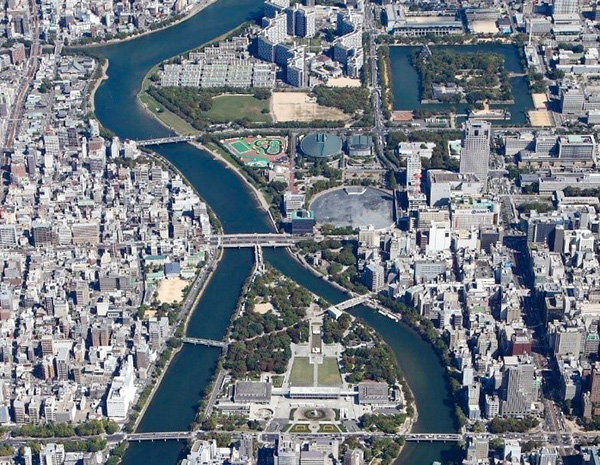
Courtesy of City of Hiroshima
The A-bomb Survivors Today
Conveying their A-bomb Experience
More than 75 years after the atomic bombing, the survivors, called hibakusha in Japanese, are becoming quite elderly. Their average age as of March 31, 2021, is over 80 years. As many have passed away every year, their numbers are dwindling.
Some hibakusha are confined to hospitals due to aftereffects, and many live in fear that illness may strike at any time.
hibakusha telling their A-bomb experiences
hibakusha find it very painful to recall their A-bomb experiences, yet many of them overcome this pain to tell their experiences to young people to help the next generation understand how extremely important peace is.
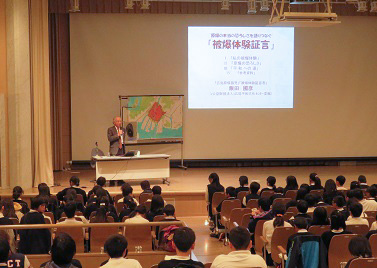
A hibakusha telling his A-bomb experience to students on a field trip.
The Ongoing Threat of New Clear Weapons
The dropping of the atomic bombs on Hiroshima and Nagasaki ushered the world into the “nuclear age.” Intense rivalry between the United States and the Soviet Union (now, Russia) and the formation of their opposing factions led to a nuclear arms race and production of vast numbers of nuclear weapons, increasing the danger of nuclear war. It has been found that there were over 10 situations in which the use of nuclear weapons was considered in the Cold War period. Many fatal accidents have occurred in the process of nuclear weapon development and through the handling of nuclear fissile material. This clearly indicates that possession of these weapons in itself is a dangerous act.
Furthermore, repeated nuclear tests have exposed countless people to radiation and caused serious environmental harm. While the United States and Russia have reduced their nuclear arsenals since the end of the Cold War system in 1991, the number of nuclear-armed states has increased. Moreover, the world now faces new concerns, including the threat of nuclear terrorism and the collapse of nuclear treaties.
If a nuclear war were to occur, vast numbers of people would be killed and wounded immediately by nuclear explosions. In addition, soot, dust and other particles from the resulting fires would be carried into the stratosphere where they would block out the sun’s rays, causing temperatures to plummet. The resulting “nuclear winter” would be global and would last for years. This would greatly impact food production, much of humanity would face starvation, and many life forms would die out.
Given the inhumanity of nuclear weapons, the international community must cooperate to achieve the total abolition of nuclear weapons as soon as possible.
World Nuclear Forces and Nuclear Test Sites Around the World
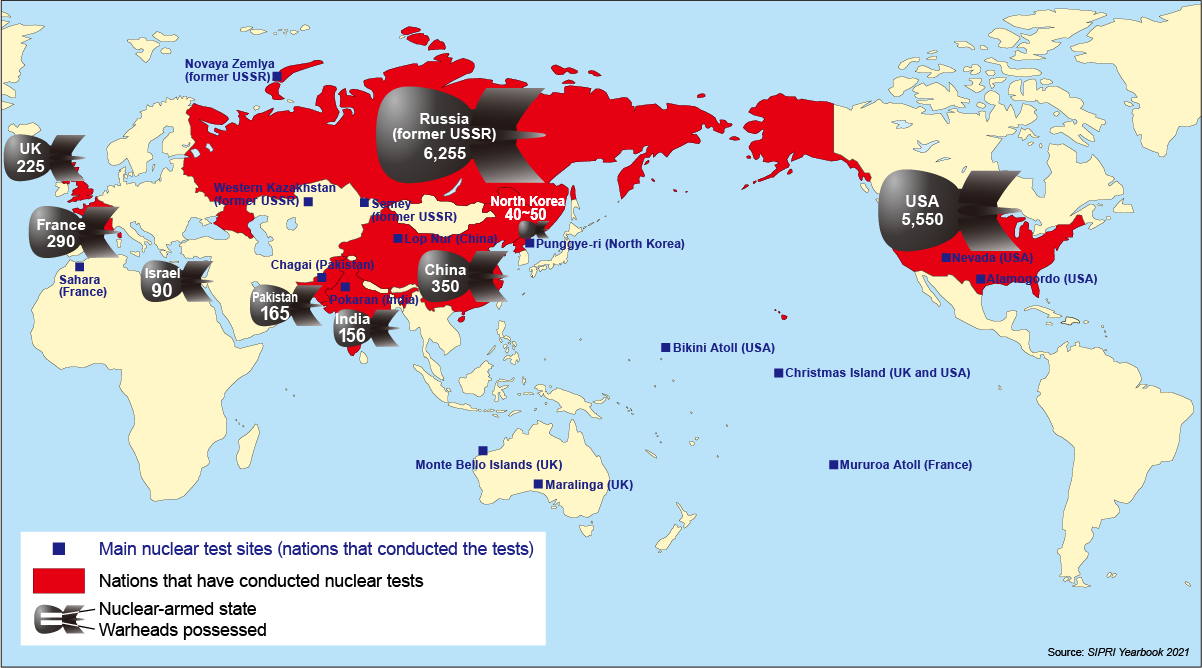
Click to see a larger image.
*Note: The figures show total estimated nuclear warheads, including deployed (on missiles or bases with operational forces), reserve, and awaiting dismantlement. Nine nuclear-armed states possess approximately 13,080 nuclear warheads, of which 3,825 are deployed and ready for use. The figures for North Korea are highly uncertain and are not included in the global totals.
Toward a Peaceful World
On the Brink of Nuclear War
During the Cold War, at one time, the world came extremely close to nuclear war. That was the Cuban Missile Crisis of 1962. The US became angry when it learned that the Soviet Union was building a missile-launching site in Cuba. The US came very close to pushing the button to launch nuclear weapons. In the end, the U.S. promised not to invade Cuba, and the Soviet Union canceled its plan to put missiles in Cuba. Thus, a nuclear war was avoided. This incident reminded the world of the dangers of possessing nuclear weapons and was led to efforts to reduce the numbers of nuclear weapons.
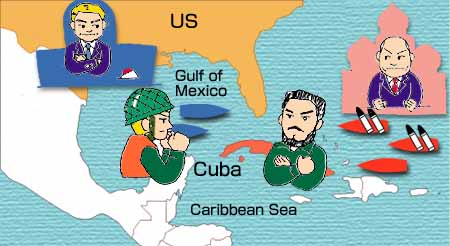
Efforts to Stop Testing and Eliminate Nuclear Weapons
In 1968, the U.S. and Soviet Union jointly proposed a treaty that said, "We want to avoid increasing the number of countries with nuclear weapons." In 1996, they signed a treaty that said, "Let's stop all tests that involve nuclear explosions." This treaty was the first agreement that prohibited even underground tests. However, this treaty is still not in effect because certain key countries have not signed it.
Despite these efforts to ban testing and eliminate nuclear weapons, tens of thousands of nuclear weapons remain, and some countries are still developing new nuclear weapons.
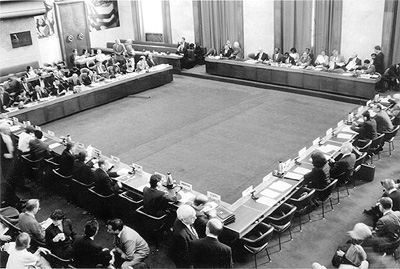
Courtesy: Asahi Shimbun
All rights reserved by the Asahi Shimbun.
NPT
NPT = Treaty on the Non-Proliferation of Nuclear Weapons
CTBT
CTBT = Comprehensive Nuclear Test Ban Treaty
The Danger to the Human Race and the Earth
As long as nuclear weapons exist, the possibility of nuclear war remains. If nuclear weapons are used again, there can be no doubt that the damage will be dozens or hundreds of times greater than that inflicted on Hiroshima. Radioactive substances will be spread over vast areas, and millions of people will suffer radiation aftereffects far into the future. It is very likely that whole cities and surrounding forests will be set on fire. The soot and smoke from those fires will envelop the Earth, causing the Earth's climate to change. Some experts have predicted that nuclear war would lead to a "nuclear winter." Nuclear weapons continue to cast a dark shadow over the future of the human race.
Simulated temperature changes for 40 days after a nuclear war
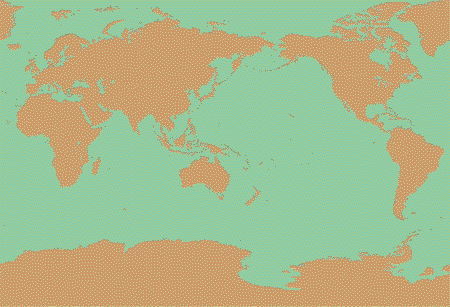
Average temperatures on the surface of the Earth are projected to fall to 30 degrees centigrade in the Western US, 40 degrees in the east, 50 degrees in Europe and the Persian Gulf, and 15 degrees in the Arctic Circle.
Source: Carl Sagan,
The Cold and the Dark, The World after Nuclear War
W.W. Norton & Company 1985
Efforts for Peace
The elimination of nuclear weapons (getting rid of them all) is not something that any one country can do alone. To accomplish this, each person around the world must have a strong desire for peace and a strong will to live in a society free from nuclear weapons. If the people of the world cooperate, we can act together and become a force powerful enough to influence nations, influence the United Nations, and achieve a peaceful world free from nuclear weapons.
Overseas A-bomb ExhibitionsTo convey the facts about A-bomb damage and urge people to work to eliminate nuclear weapons, every year, Hiroshima and Nagasaki hold A-bomb exhibitions in various cities around the world.
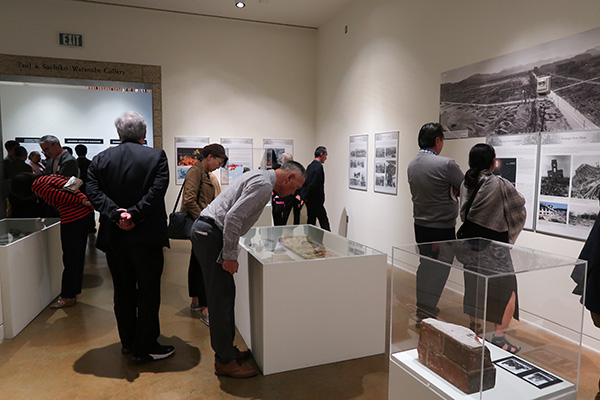
November 2019
Japanese American National Museum (Los Angeles, US)
Courtesy of Hiroshima Peace Culture Foundation


